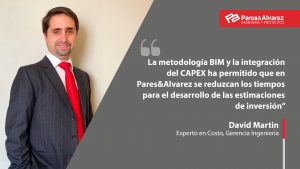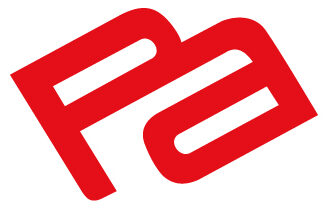BIM METHODOLOGY AND INVESTMENT COST MANAGEMENT
- Home
- What´s New
- BIM methodology and investment cost management

july 11, 2022
David Martin
Cost Expert, Engineering Management
CAPEX management is a common activity in the projects we develop at Pares&Alvarez and is always in the focus of our clients. A tool that we have found successful in meeting this objective is to perform trend analysis and integrate CAPEX as a use within the BIM methodology. This method, together with practices that aim to increase the level of engineering information in the estimates, has allowed us to achieve budgets with values of less than 10% deviation with respect to the real investment once construction is completed. The above has motivated us to deepen in ways of working that facilitate the management of CAPEX within BIM projects.
Building Information Modeling or BIM is a multidisciplinary collaborative methodology based on a dynamic model, which is built by the professionals responsible for the different areas of the project, who assign different properties and characteristics to the items and elements during the elaboration of the model.
The information structured in the BIM model is scalable, measurable and extractable to be analyzed during the engineering development, allowing interference analysis, assembly sequences, design optimizations and several other uses that the project considers relevant. All the above provides information for the early management of emerging issues that appear during the development of the project.
A relevant advantage of this methodology is that it also allows the analysis of quantity trends and monitoring and comparison of the estimated budget in the previous stages of the project. This evolution of the model allows comparing, analyzing and evaluating control measures, construction strategies, mitigation plans to optimize project execution time and costs.
Considering that the industry, in recent years, has required more frequently the use of this methodology in their investment projects and verifying the value that our clients give to trend analysis and budget control, Pares&Alvarez has developed a list of standardized items with unique codification and integrated to the database of developed projects. This list is entered into a platform for integration of the MTO (Material Take Off) of the BIM model to the CAPEX estimation model, which subsequently allows the BIM model to be fed back with cost and performance information, in order to achieve a more efficient 4D and 5D modeling and meet the objective of controlling the budget and optimizing the construction program of the project with information that is always updated according to the progress of the model.
Pares&Alvarez and in particular the Cost and Constructability area has identified comparative advantages in the use of BIM methodology in projects, which has motivated the update and implementation of new cost estimation procedures focused on this methodology, standardizing the structures and content of the MTOs developed by the engineering disciplines.
Therefore, the BIM methodology and the integration of CAPEX has allowed Pares&Alvarez to reduce the time for the development of investment estimates, focusing the cost team in the budget analysis and the general consistency of the project, generating value not only from the technical and modeling point of view, but also contributing to the objective of delivering an integral service from the different perspectives of the project stakeholders.
Finally, the active control of the budget is an integral task within the management of a project and the developments of Pares&Alvarez within the framework of the BIM methodology contribute to the successful fulfillment of this objective.
